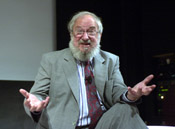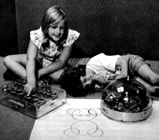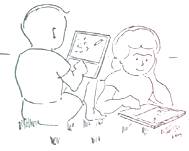Constructionism
 The ideas on this web site really converge around the work Seymour Papert, the father of Constructionism, a mathematician and educator. At MIT, he was a founder of the Artificial Intelligence Lab as well as the Media Lab. On the back cover of the is book Mindstorms, in which Papert tells the story of the first educational programming language, Logo, Marvin Minsky called Papert "the greatest of all living education theorists". (Picture above: Seymour Papert. Below: The Logo turte robot in action, drawing shapes.)
The ideas on this web site really converge around the work Seymour Papert, the father of Constructionism, a mathematician and educator. At MIT, he was a founder of the Artificial Intelligence Lab as well as the Media Lab. On the back cover of the is book Mindstorms, in which Papert tells the story of the first educational programming language, Logo, Marvin Minsky called Papert "the greatest of all living education theorists". (Picture above: Seymour Papert. Below: The Logo turte robot in action, drawing shapes.)

Papert's thoughts on education were shaped by the great Swiss developmental psychologist Jean Piaget, with whom he worked for three years in Geneva prior to moving to the MIT.
Today, Papert's educational work at the MIT is carried on by his former student, Mitch Resnick, at the Lifelong Kindergarten lab, which developed the Scratch programming language.
One close and remarkable collabor of Papert was Alan Kay, a visionary computer scientist who invented the concept of object-oriented programming, co-developed Smalltalk, the language which Scratch was initially written in, as well as Etoys. (Scratch is currently being re-written in Flash, and Version 2.0 is scheduled to be released as a fully web-based tool in early 2012.)

When did you send your first email? The World Wide Web was invented in 1989. What had you heard much of computers before that? Maybe you even had a Commodore 64 or an Apple II? The picture shows a sketch by Alan Kay, drawn in 1987, envisioning the future of computing: Kids on a field, interactively playing with portable computers. Note that he sketched two kids, not one. In my opinion, this immediate, playful immersion in nature remains our challenge today, to get our kids away from the Wii and back into the real world!
Papert summarized his concept of constructionis learning in an application for NSF funding as follows:
Constructionism: A New Opportunity for Elementary Science Education
ABSTRACT
The word constructionism is a mnemonic for two aspects of the theory os science education underlying this project. From constructivist theories of psychology we take a view of learning as a reconstruction rather than as a transmission of knowledge. Then we extend the idea of manipulative materials to the idea that learning is most effective when part of an activity the learner experiences as constructing a meaningful product. Specifically a set of new materials will be developed for learning science in elementary schools. The materials use a new cut across science, organizing many traditional concepts under the heading of motion science, information science and color science. The materials will be designed to make better use of the level of computers presence that is now becoming common in schools. The design of the new materials pays special attention to the role of affective, cultural and gender-related facets of learning science. The materials will be developed in an inner city public school in Boston and evaluated in a number of test sites at associated schools in several states for dissemination to schools covering the full range of socio- cultural variation in American education.
- Login to post comments